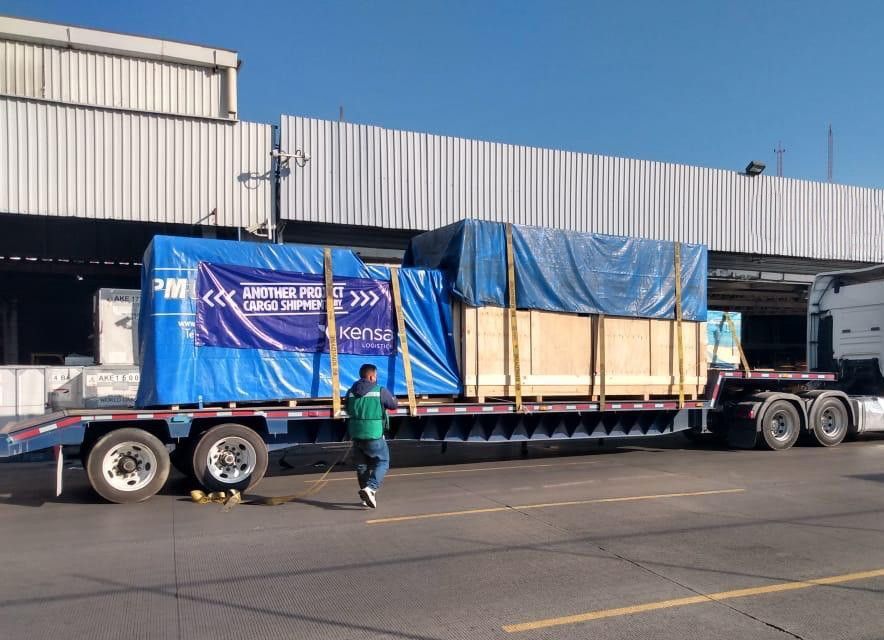Lowboy Freight Transport: What It Is, Types, and Features
Have you ever wondered how massive excavators or cranes are safely transported on the roads? The answer lies in a trusted ally: lowboy freight transport.
This specialized type of trailer is designed to move oversized equipment, ensuring safety and efficiency.
Transporting large machinery is no simple task. Height, weight, and space restrictions on the roads create constant challenges. Any logistical error can also delay projects and incur unnecessary costs.
That’s why, with the right guidance, your company can ensure that loads arrive on time and in perfect condition, minimize the risk of accidents and improve project planning.
Looking to optimize your transport operations?
In our article, you'll discover everything you need to know about this specialized type of trailer and its features.
What is a Lowboy and How Does It Work?
When we talk about lowboy freight transport, we mean a system designed to move large, heavy machinery or equipment that cannot be transported conventionally.
The name "lowboy" comes from the trailer's characteristic design, which features a low, ground-level platform, allowing tall loads to be transported without exceeding legal height limits.
Typically, a lowboy trailer consists of two levels: a raised front section that connects to the truck cab and a low rear section designed to carry equipment such as excavators, cranes, tractors, or even industrial components.
Types of Lowboy Trailers
Each type has specific characteristics to meet various needs:
- Two-axle lowboy:
Capable of carrying up to 40 tons, making it ideal for construction machinery like excavators or bulldozers, as well as heavy vehicles that cannot travel on regular roads due to weight or size restrictions.
- Three-axle lowboy:
Supports up to 55 tons, suitable for transporting larger industrial equipment such as cranes or heavy mining machinery.
- Multi-axle lowboy:
With a capacity of up to 70 tons, this type is used when loads require a broader weight distribution to avoid road damage or comply with regulations.
- Removable Gooseneck (RGN) Lowboy:
RGNs are highly versatile because the "gooseneck" (the front part connecting to the truck cab) can be removed, allowing equipment to be loaded from the front.
- Extendable lowboy:
Features an adjustable platform that extends to accommodate long loads such as pipes, wind turbine blades, beams, or prefabricated structural components.
- Hydraulic suspension lowboy:
Allows the trailer height to be adjusted according to terrain or load requirements, ensuring stability during transport.
- Adjustable platform lowboy:
Useful for transporting items of varying heights or requiring special leveling to prevent damage.
- Side-load lowboy:
Designed for loading and unloading from the sides instead of the front or rear.
Lowboy Features
Lowboy freight transport offers versatility, stability, and capacity, making it an excellent option:
- Low trailer height:
Enables the transport of equipment exceeding conventional height limits, such as excavators, cranes, or heavy agricultural equipment, without violating road regulations.
- Heavy load capacity:
Can handle between 40 and over 80 tons, depending on its configuration and design.
- Optimized loading and unloading:
Proximity to the ground facilitates the process, reducing the need for additional ramps or specialized equipment.
- Compliance with road regulations:
Key to avoiding penalties and ensuring safety.
- Stability:
Reduces the risk of tipping or sudden movements on curved or steep roads.
- Durable suspension:
Protects both the vehicle and the load during long trips or on rough terrain.
- Multiple axle configurations:
Options include two, three, or more axles depending on the weight and type of load.
- Access to difficult terrains:
Its low, robust design allows entry into challenging locations such as construction sites or rural areas.
- Improved ability to handle slopes:
An excellent option for projects in mountainous or sloped areas.
- Compatibility with various trucks:
Easily integrates into existing transport fleets without requiring significant additional investment in specialized vehicles.
What Is It Used For?
A lowboy is much more than just a trailer, as it serves a wide variety of industries:
- Heavy and oversized machinery:
Its low platform allows for the transport of large objects such as shipping containers, storage tanks, and prefabricated structures.
- Construction:
Perfect for moving materials like steel beams, concrete blocks, and other structural components from one site to another.
- Energy industry:
Ideal for transporting large, heavy equipment such as generators, turbines, and power plant components.
- Infrastructure projects:
Particularly useful for transporting machinery and materials needed for bridge construction.
- Event equipment:
For stages and sound systems, ensuring they arrive at their destination without issues.
- Commercial relocations:
Helps businesses move their operations to new locations.
- Emergency services:
In natural disasters, lowboys transport rescue equipment and humanitarian aid.
- Mining:
Essential for transporting heavy machinery and other equipment in the mining sector.
- Agriculture:
Useful for moving harvesters and seeders, especially in uneven terrains.
If your company is looking for efficient and safe solutions for heavy loads, now is the time to act.
At KENSA Logistics, we specialize in getting your goods to their final destination without any issues.
With our ground transportation service, we ensure last-mile delivery, verifying that every shipment meets the high standards of trust our clients deserve.
If you urgently need an integrated logistics solution that takes care of your products every step of the way, we are your best ally.



